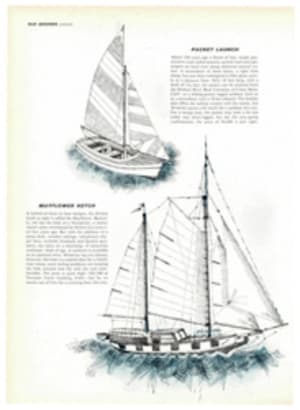
THE MYSTERY OF THE WALLEYES AND THE WATER
There was nothing in the peaceful Sunday morning landscape to show that poison flowed in the river. The broad Susquehanna was placid below its wooded shores, and the group of fishermen who had come out from Wilkes-Barre looked forward to a good day's sport. Then they saw the fish, surfacing at a big riffle across the stream. They were walleyed pike and they appeared to be sick or stunned, moving sluggishly into shallow water, where they lay helpless.
Giving up their sport for the day, the fishermen organized a spontaneous conservation project; they transported some of the walleyes to a pool in Harvey's Creek, a stream nearby. But the walleyes died in Harvey's Creek just as their fellows died in the murky Susquehanna.
The fishermen reported the incident and went their way. Though they did not know it, they had launched a new and possibly crucial skirmish in the long struggle between conservationists and the industrial users of water. By last week this month-old incident had grown into a sizable conflict. The Pennsylvania Fish Commission determined that 116,280 fish had died and the north branch of the Susquehanna had been ruined for perhaps three years as a fishing stream. But for all of this, the real impact of the conflict lay in the fact that a new and potent weapon was introduced: money.
Broadly speaking, Pennsylvania conservationists, like those elsewhere, have had to rely on public opinion to gain their ends. The 60 fish wardens employed by the state fish commission might arrest an occasional profligate angler with more than his limit of fish, or a factory might be fined for having dumped large quantities of toxic liquids into a river; but, by and large, police power could not be exerted to keep fish and game abundant and streams pure.
Now, however, public opinion in Pennsylvania has been given a practical value. What is arising out of the Susquehanna case is a new concept of responsibility for destroying natural resources. To be specific, the fish commission thinks that whoever caused the deaths of the 116,280 fish should pay $58,504.50 for them—and the commission is pretty sure it knows who is responsible.
On the day following the first report, officials tested the water without discovering anything wrong. Next day a man named Donald Roberts reported to a fish warden that he had seen dead fish in the river near the town of Catawissa, some 36 miles downstream from where the first stricken walleyes were noted.
The fish commission consists of eight unpaid members, who make policy, and a paid executive director, who administers it. The commission member nearest the scene was Maynard Bogart from the town of Danville. "I went down to look into it myself," Bogart said. "I saw plenty of dead and dying fish. Some were jumping right out on the bank."
Bogart also called the nearest fish warden. Reports were now coming in constantly, and fisheries officials throughout the state were alerted. Bogart tried to telephone Robert Bielo, a state fish biologist, at the fish commission headquarters in Harrisburg. "I hung up and turned around and answered a knock at the door," Bogart said. "It was Bielo." The two men calculated that whatever was causing the trouble was moving down the river at about eight miles a day, and they hurried to a point downstream from Danville, where Briar Creek empties into the Susquehanna, to watch the reaction when the contamination reached that point. They met health department officials there. "They said they had investigated earlier reports but hadn't found anything," Bogart said. "Well, this time they did. I picked up a dead walleye and handed it to them."
Bielo counted 44 dead walleyes and one dead bass in a single eddy. The area where the dead fish were found extends from below Wilkes-Barre through gently rolling lands to the town of Sunbury (see map), a distance of 55 miles. Bielo and his crew retraced the entire route back to Wilkes-Barre, counting dead fish as they went. On the basis of their samples, running to about 700 for every 400 to 600 yards of the river, they estimated that 116,280 fish had been killed—big fish, that is, all of legal size to be taken by anglers.
On the same day that Bielo and his crew finished enumerating dead walleyes, the seeming source of the pollution was found. The Sanitary Water Board ordered the Glen Alden Mining Company of South Wilkes-Barre to cease operating a new pumping station that had gone into operation in early October.
Albert Day, executive director of the fish commission, is convinced that these new, 4,000-gallon-a-minute pumps caused the trouble. "It will take two or three years for the river to recover," said Day. The fish commission held that the Glen Alden pumps were drawing up stagnant water and wastes from deep shafts, untouched for three years and laden with iron, sulphur and highly concentrated minerals that formed lumps of scum like snowflakes. The fish were dying because the minerals absorbed the oxygen in the water—although, said Bielo, the sulphuric acid alone was so bad it was enough to kill the fish.
Two weeks after the fishermen first noticed the walleyes surfacing, the fish commission met secretly to decide what it would do about the catastrophe. As a result, it passed a resolution asking that the Glen Alden Company be assessed $58,504.50 for the fish that had been killed. (Bass under 10 inches were estimated at $1, over 10 inches at $1.30 and walleyes over 10 inches at $1.50.) To enforce collection, the water board would refuse to let the pumps be started—even experimentally—until the money had been paid, the fish commission pledging that the entire amount would be used to restore walleye and bass to the depleted area.
The Glen Alden Company, which had promptly shut down its pumps at the water board's order, argued that it had done nothing illegal. Furthermore, it pointed out, a permanent stoppage of the pumps would throw some 1,080 needy miners out of work. Franklin Gelder, the company's general counsel, added: "Nor do we admit that the fish killed resulted from pollution coming from our mine. I don't see how anybody can isolate this."
Whatever the legal merits of Commissioner Day's proposal, there was no doubt but that he had aroused a good deal of interest among conservationists. The water board and fish commission were on record as holding the mine company responsible for the fish kill; a legislative subcommittee had also joined the inquiry and reached the same conclusion. "If a farmer had contaminated the water," said its chairman, "he would have been arrested at once." Moving along with what appeared to be the current of public opinion, Commissioner Day placed the whole matter in the office of the attorney general of the state. He said vehemently that he had no doubt that a suit would be brought against Glen Alden, forthwith. Meanwhile, after two days of drenching rain appreciably raised the level of the Susquehanna, the mining company was permitted to start its pumps again—at half capacity.
And there, for the time being, rests the case of the walleyes of the Susquehanna. If Commissioner Day should achieve what he wants, the result would be a revolutionary new concept of the law and conservation. For the first time the despoiler of a trout stream would be held responsible for the enjoyment he has taken away from his fellow citizens. If such a determination can be made, and made without sacrifice of human rights, those walleyed pike that floated to the surface of the Susquehanna to the astonishment of Sunday anglers would indeed have become historic.
MAP
TOXIC RIVER, Susquehanna's north branch, is victim of pollution by Wilkes-Barre mines.
PENNSYLVANIA
WILKES-BARRE
PLYMOUTH
GLEN ALDEN MINES
NANTICOKE
SUSQUEHANNA RIVER
CATAWISSA
DANVILLE
SUNBURY
HARRISBURG
PHOTO
BASSE BECK OF SUNBURY FOUND THESE DEAD FISH IN RIVER NEAR CATAWISSA

